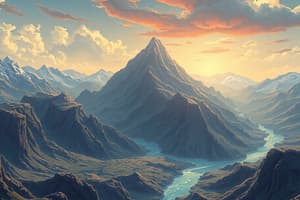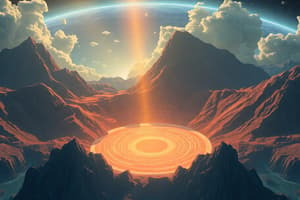Podcast
Questions and Answers
What type of fault is characterized by the hanging wall moving down due to tension?
What type of fault is characterized by the hanging wall moving down due to tension?
- Strike-Slip Fault
- Normal Fault (correct)
- Reverse Fault
- Transform Fault
Which type of volcanic eruption is most closely associated with explosive events and alternating layers of lava and ash?
Which type of volcanic eruption is most closely associated with explosive events and alternating layers of lava and ash?
- Shield Volcano
- Fissure Volcano
- Cinder Cone Volcano
- Composite Volcano (correct)
What is the term for the point inside the Earth where an earthquake begins?
What is the term for the point inside the Earth where an earthquake begins?
- Fault Line
- Magnitude Point
- Focus (correct)
- Epicenter
Which seismic waves are the fastest and can travel through solids, liquids, and gases?
Which seismic waves are the fastest and can travel through solids, liquids, and gases?
At which type of plate boundary would you most likely find mountain building processes occurring?
At which type of plate boundary would you most likely find mountain building processes occurring?
What is the main outlet through which magma escapes to the surface of a volcano called?
What is the main outlet through which magma escapes to the surface of a volcano called?
Which tectonic plate boundary type involves plates sliding past each other horizontally?
Which tectonic plate boundary type involves plates sliding past each other horizontally?
What type of tsunami formation is most often attributed to underwater volcanic eruptions?
What type of tsunami formation is most often attributed to underwater volcanic eruptions?
What are fast-moving currents of hot gas and volcanic matter during an eruption called?
What are fast-moving currents of hot gas and volcanic matter during an eruption called?
Which of the following is not a type of seismic wave?
Which of the following is not a type of seismic wave?
Study Notes
Plate Boundaries
- Divergent Boundaries: Plates move apart, example: Mid-Atlantic Ridge.
- Convergent Boundaries: Plates move towards each other, example: Himalayas.
- Transform Boundaries: Plates slide past each other, example: San Andreas Fault.
Processes at Plate Boundaries
- Earthquakes: occur at all types of boundaries.
- Volcanoes: mostly occur at convergent and divergent boundaries
- Mountain Building: typically occurs at convergent boundaries.
Faults and Earthquakes
- Normal Faults: caused by tension, hanging wall moves down.
- Reverse Faults: caused by compression, hanging wall moves up.
- Strike-Slip Faults: caused by shearing, rocks slide past each other horizontally.
- Focus: point inside the Earth where the earthquake starts.
- Epicenter: point on Earth's surface directly above the focus.
- Magnitude: measure of energy released, often measured by the Richter scale.
- Seismograph: instrument that records seismic waves.
Seismic Waves
- Primary Waves (P-Waves): fastest, travel through solids, liquids, and gases.
- Secondary Waves (S-Waves): slower than P-waves, travel only through solids.
- Surface Waves: slowest, cause the most damage, travel along Earth’s surface.
Volcanoes
- Shield Volcanoes: broad, gently sloping, formed by low-viscosity lava.
- Composite Volcanoes (Stratovolcanoes): steep, explosive eruptions, alternating layers of lava and ash.
- Cinder Cone Volcanoes: small, steep, formed from tephra.
- Lava Flows: molten rock flowing from a volcano.
- Ash Falls: volcanic ash falling from the sky.
- Pyroclastic Flows: fast-moving currents of hot gas and volcanic matter.
- Magma Chamber: large underground pool of molten rock beneath Earth's crust.
- Main Vent: primary outlet through which magma escapes to the surface.
- Throat: uppermost section of the main vent.
- Crater: bowl-shaped depression at the top of the volcano, formed by explosive activity.
- Conduit: passage through which magma travels to reach the surface.
- Ash Cloud: cloud of ash formed during explosive volcanic eruptions.
- Secondary Vent: smaller outlets on the sides of a volcano where magma can also escape.
- Secondary Cone: smaller cones formed by eruptions from secondary vents.
- Eruption Column: towering plume of ash, gas, and volcanic material ejected into the atmosphere.
- Lava Dome: mound formed when lava is too viscous to flow far from the vent.
- Fumaroles: openings in Earth's crust that emit steam and gases.
- Sills: horizontal intrusions of magma that solidify between layers of rock.
- Dikes: vertical or steeply inclined intrusions of magma that cut through existing rock layers.
- Caldera: large, basin-like depression formed when a volcano collapses into itself, often following a major eruption.
- Lahar: destructive mudflow on the slopes of a volcano, typically composed of volcanic ash mixed with water.
Studying That Suits You
Use AI to generate personalized quizzes and flashcards to suit your learning preferences.
Description
Test your knowledge on the different types of plate boundaries and the geological processes that occur at each. This quiz covers essential concepts like faults, earthquakes, and volcanic activity associated with these boundaries. Perfect for Earth Science students!




